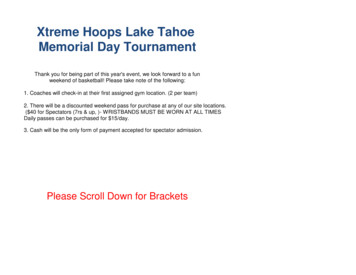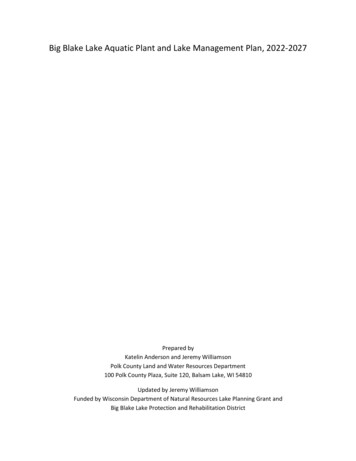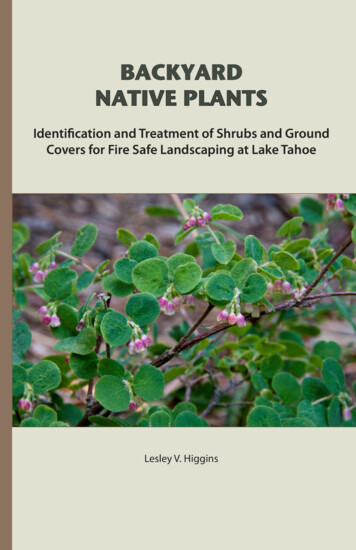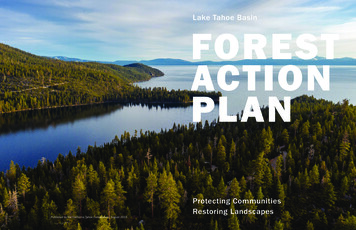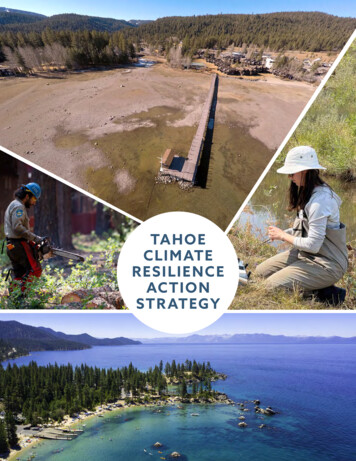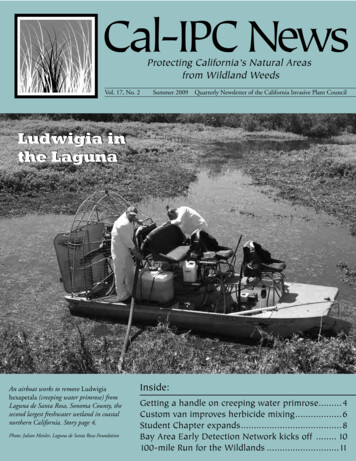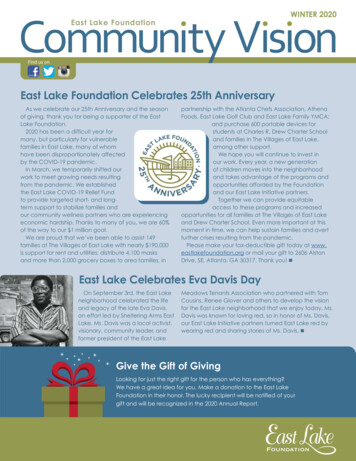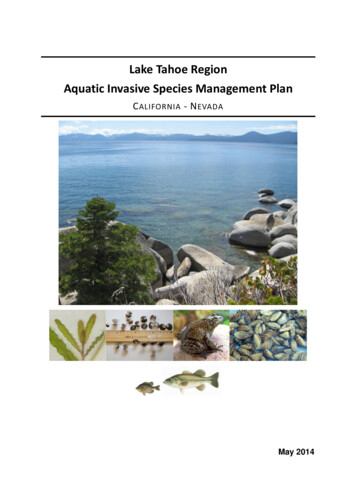
Transcription
Lake Tahoe RegionAquatic Invasive Species Management PlanC ALIFORNIA - N EVADAMay 2014
This Aquatic Invasive Species Management Plan is part of a multi-stakeholder collaborativeeffort to minimize the deleterious effects of nuisance and invasive aquatic species in the LakeTahoe Region. The Tahoe Regional Planning Agency, as created by California, Nevada, and theU.S. Congress (P.L. 96-551, 94, Stat. 3235) provides oversight to the implementation of thisplan, including acting as the fiscal agent, or pass through agency for funds associated with itsimplementation.This product was prepared by:Suggested citation: TRPA (Tahoe Regional Planning Agency). 2014. Lake Tahoe RegionAquatic Invasive Species Management Plan, California - Nevada. 35 pp. Appendices.Cover photo credits: Lake Tahoe shoreline, Toni Pennington (Tetra Tech, Inc.); curlyleaf pondweed, Steve Wells (PSU); Asianclams, Brant Allen (UCD); bullfrog (USGS), zebra mussels (USGS); bluegill and largemouth bass (USACE)
AQUATIC INVASIVE SPECIES MANAGEMENT PLANTable of Contents – Main ReportPageAcknowledgements . xAcronyms .xiGlossary .xiiExecutive Summary .xvi1 Introduction . 11.1Geographic Scope: Lake Tahoe Region. 11.2Existing Authorities and Programs. 41.3Gaps and Challenges . 101.4Plan Oversight . 112 AIS Management Approach. 122.1Prevention. 122.2Monitoring . 132.3Control/Eradication. 132.4Education . 142.5Research. 152.6Continual Improvement. 153 Problem Definition and Ranking. 183.1Background . 183.2Pathways of Introduction . 204 Plan Development . 264.1The 2009 Plan. 264.2The 2014 Plan Revision . 285 Management Plan Goals and Objectives. 305.1Objective A: Oversight and Internal Coordination . 305.2Objective B: Prevention . 305.3Objective C: Monitoring, Detection, and Response . 305.4Objective D: Long-Term Control . 316 Plan Review . 327 Literature Cited. 34Table of Contentsi
AQUATIC INVASIVE SPECIES MANAGEMENT PLANList of TablesTable 1. Federal, State, and Regional Agencies, Regulations and Programs in the Lake TahoeRegion and Associated AIS Activities. 8Table 2. Inter-Region Recreational Waterbodies . 21Table 3. Intra-Region Recreational Waterbodies . 22Table 4. Non-Native Species Management Types . 25Table 5. Lake Tahoe Region AIS Management Plan Objectives. 31List of FiguresFigure 1. Lake Tahoe Region . 2Figure 2. Model of Increasing Costs Based on Invasion Process and Management Response. 13Figure 3. Lake Tahoe AIS Management Plan Development Timeline. 27AppendicesAppendix A Regulations and ProgramsAppendix A1: Existing Authorities and ProgramsAppendix A2: Lake Tahoe AISCC CharterAppendix B AIS of ConcernAppendix C Short- and Long-Term Strategies and Actions and Implementation TableAppendix D Prevention PlanningAppendix D1: Non-motorized Inspection Implementation PlanAppendix D2: Watercraft Inspection Implementation PlanAppendix EControl and Eradication PlanningAppendix E1: Aquatic Plant ControlAppendix E2: Asian Clam ControlAppendix FMonitoring and Response PlanningAppendix F1: AIS Early Detection Plan: Zebra and Quagga Mussel Veliger MonitoringAppendix F2: Lake Tahoe Basin Interagency Dreissenid Mussel Rapid Response PlanAppendix GFinance PlanAppendix G1:Appendix G2:Appendix G3:Appendix G4:Appendix HAppendix IAppendix JPotential Economic Impacts of Aquatic Invasive SpeciesAIS Funding Strategy Synthesis MemoAIS Stakeholder Interview MemoEconomic Consequences of Aquatic Invasive Species in Lake TahoeSummary of CommentsContributors and ResourcesKey Management QuestionsTable of Contentsii
AQUATIC INVASIVE SPECIES MANAGEMENT PLANTable of Contents – Appendix A: Regulations and ProgramsPageAppendix A1: Existing Authorities and Programs. A1-11 Federal2 State and Regional3 Literature CitedPageAppendix A2: Lake Tahoe Aquatic Invasive Species Coordination Committee Charter . A2-1Table of Contents – Appendix B: AIS of ConcernPageAquatic Invasive Species of Concern . B-11 Non-Native Species Present or Threatening Lake Tahoe2 Non-Native Species Types3 Literature CitedList of TablesTable 1. Aquatic Herbicides Registered by California Department of Pesticide Regulation,Nevada Department of Agriculture, and/or the U.S. EnvironmentalProtection AgencyTable 2. Non-Native Species Management TypesTable 3. Non-Native Species Presently In or Threatening the Lake Tahoe RegionList of FiguresFigure 1. Potential distribution of submersed plants (e.g., curlyleaf pondweed and Eurasianwatermilfoil) in Lake TahoeFigure 2. Distribution of quagga and zebra mussels in the western U.S.Figure 3. Potential quagga and zebra mussel habitat in Lake Tahoe (survival depth 130 m)Figure 4. Distribution of New Zealand mudsnails in the U.S. (red dots)Table of Contentsiii
AQUATIC INVASIVE SPECIES MANAGEMENT PLANTable of Contents – Appendix C: Short- and Long-TermStrategies and Actions and Implementation TablePageShort- and Long-Term Strategies and Actions and Implementation Table . C-1Objective A: Oversight and Internal CoordinationStrategy A1: Plan Oversight and CoordinationStrategy A2: Plan ReviewStrategy A3: FundingStrategy A4: Regional, Bi-state, National, and International CollaborationStrategy A5: AIS Laws and RegulationsObjective B: PreventionStrategy B1: Motorized Inspection and DecontaminationStrategy B2: Non-motorized Inspection and DecontaminationStrategy B3: Pathways/VectorsStrategy B4: EducationStrategy B5: Prevention Evaluation and UpdateObjective C: Monitoring, Detection, and ResponseStrategy C1: Potential AISStrategy C2: Existing AISStrategy C3: Early Detection and Rapid Response PlanningStrategy C4: AIS Life Histories and Environmental RequirementsObjective D: Long-Term ControlStrategy D1: Provide for All Appropriate Treatment and Control MeasuresStrategy D2: Aquatic Plant ControlStrategy D3: Asian Clam ControlStrategy D4: Warm Water Fish ControlStrategy D5: Bullfrog ControlStrategy D6: Long-term Control OutreachImplementation TableLiterature CitedList of TablesTable 1. Lake Tahoe Region AIS Management Plan Implementation Table (Revised 2014)Table of Contentsiv
AQUATIC INVASIVE SPECIES MANAGEMENT PLANTable of Contents – Appendix D: Prevention PlanningPageAppendix D1: Non-Motorized Inspection Implementation Plan . D1-1Purpose and ObjectivesBackgroundRegulationsInspection ProtocolLogistics and AccountingProgram EvaluationList of AttachmentsAttachment 1: How to Inspect and Decontaminate your VesselAttachment 2: Hand-Launched Watercraft Inspection Survey and Screening FormAttachment 3: Information Recorded on Data FormPageAppendix D2: Watercraft Inspection Implementation Plan . D2-1IntroductionBackgroundRegulationsInspection Locations and ScheduleInspection ProceduresWatercraft Inspection FeeProgram EvaluationTable of Contentsv
AQUATIC INVASIVE SPECIES MANAGEMENT PLANTable of Contents – Appendix E: Control and EradicationPlanningPageAppendix E1: Aquatic Plant Control. E1-1IntroductionPurpose and ObjectivesLocationMethodsDurationPurpose of Initial Study/Environmental AssessmentList of TablesTable 1. Summary of Plant Control Methods Used in Emerald Bay, 2011Table 2: Known Aquatic Plant Infestations and TreatmentsTable 3: Typical Annual Aquatic Weed Control YearList of FiguresFigure 1. Results of Aquatic Plant Monitoring in Emerald Bay, 2008-2011Figure 2. Project Area: Potential Habitat for Submerged Aquatic PlantsFigure 3. Potential AIS Weed Treatment SitesPageAppendix E2: Asian Clam Control . E2-1A. IntroductionB. Problem StatementC. Asian Clam Management PhasesD. Timeline and Related CostsE. Define Working Group and Partner RolesF. Communication SystemTable of Contentsvi
AQUATIC INVASIVE SPECIES MANAGEMENT PLANList of Tables – Appendix E, cont.Table 1. Cost breakdown for five year projectTable 2. Total amount requested from executive committee less other available funds for initialtwo year period of proposed projectTable of Contents – Appendix F: Monitoring and ResponsePlanningPageAppendix F1: AIS Early Detection Plan: Zebra and Quagga Mussel Veliger Monitoring .F1-1ObjectiveMonitoring Locations and FrequencyMethods – Veliger Plankton TowPageAppendix F2: Lake Tahoe Basin Interagency Dreissenid Mussel Rapid Response Plan .F2-1I.II.III.IV.V.VI.IntroductionLegal Authority for Rapid ResponseScope and PurposeA. Planning AssumptionsB. ResponsibilitiesConcept of OperationsA. Coordination Structure B. Management StructureInteragency Response ProceduresA. Response Objectives B. 17 Step Rapid Response Procedures (California Plan Example)ReferencesList of AppendicesAppendix A: Dreissenid BiologyAppendix B: Rapid Response Checklists/Field OperationsAppendix C: Notification Lists/ProceduresAppendix D: Containment, Control and Eradication1. Control Options2. Response Scenarios3. Scenario-Based Eradication and Control Options4. Methods for In-Situ Evaluation of Chemical Control EffectivenessAppendix E: Regulatory RequirementsAppendix F: Contingency PlansAppendix G: Sample Documents1. Model Letter of Agreement2. Sample Press Release in the Event of Discovery of Dreissenid Mussels3. Sample Declaration of Emergency4. Sample Delegation of AuthorityAppendix H: FormsAppendix I: GlossaryTable of Contentsvii
AQUATIC INVASIVE SPECIES MANAGEMENT PLANTable of Contents – Appendix G: Finance planPageAppendix G1: Potential Economic Impacts of AIS . G1-11. Objectives2. Economic Study Area3. Potential Effects of AIS on the Regional Economy4. Summary of Potential AIS Economic Impacts5. AIS Management Costs6. Conclusions7. Literature CitedList of TablesTable 1. Population History and Projection, Greater Lake Tahoe Area, 1990-2026Table 2. Populations within the Lake Tahoe Region, 2000Table 3. Tourism-Induced Direct Employment, Lake Tahoe Region, 1999Table 4. Lake Tahoe Region Outdoor Summer Recreation Visitation StatisticsTable 5. Estimated Recreation Participation ImpactsTable 6. Estimated Recreation Impact ScenariosTable 7. Visitor Spending by County, May-October 2008Table 8. AIS-Induced Reduction Scenarios, 2008Table 9. Summary Table: Private Property Values in the Lake Tahoe RegionTable 10. Summary Table: Public Property Values in the Lake Tahoe RegionTable 11. AIS Impacts on Private Property ValuesTable 12. Estimated Water Supply Infrastructure CostsTable 13. Summary of AIS Economic ImpactsTable 14. AIS Funding Awards and Sources from January 2007 to May 2009List of FiguresFigure 1. AIS Funding by Task and Category from January 2007 to May 2009PageAppendix G2: AIS Funding Strategy Synthesis Memo . G2-1Appendix G3: AIS Stakeholder Interview Memo .G3-1Appendix G4: Economic Consequences of Aquatic Invasive Species in Lake Tahoe .G4-1Table of Contentsviii
AQUATIC INVASIVE SPECIES MANAGEMENT PLANTable of Contents – Appendix H: Summary of CommentsPageSummary of Comments H-2Table of Contents – Appendix I: Contributors and ResourcesPageContributors and Resources .I-Error! Bookmark not defined.1 Authors and Reviewers2 Stakeholders and ContributorsList of TablesTable 1. Lake Tahoe Aquatic Invasive Species Coordination CommitteeTable 2. Internet Aquatic Invasive Species ResourcesList of AttachmentsAttachment 1: Letter in Support of Forming the Lake Tahoe Aquatic Invasive SpeciesCoordination CommitteeTable of Contents – Appendix J: Key Management QuestionsPageKey Management Questions.J-1EnvironmentalManagementInteraction with Other Existing AISSurveysVector PathwaysClimate ChangeTable of Contentsix
AQUATIC INVASIVE SPECIES MANAGEMENT PLANAcknowledgementsThis update to Lake Tahoe Region AIS Management Plan (the Plan) was made possible bymembers of the Lake Tahoe Aquatic Invasive Species Coordination Committee (AISCC) (listedbelow). The AISCC was critical in guiding plan revisions, specifically updating theImplementation Table (Appendix C) and identifying key management questions. For the 2014version, the AISCC took the opportunity to identify portions of the Plan that were more staticwhile allowing for annual updates of ongoing efforts by the various Lake Tahoe AIS workinggroups. These annual reports, now provided as Appendices to the Plan, illustrate the dedicatedand successful efforts by resources managers in the Lake Tahoe Region.Funding for this project was made possible through the U.S. Fish and Wildlife Service (USFWS)in support of implementing State/Interstate Aquatic Nuisance Species Management Plans and inkind staff contributions from the AISCC. The authors wish to thank Don MacLean (USFWS) forreviewing an early draft of the revised plan prior to formal submittal to the Aquatic NuisanceSpecies Task Force (ANSTF).Lake Tahoe Aquatic Invasive Species Coordination Committee:California Tahoe ConservancyCalifornia Department of Fish and WildlifeCalifornia Department of Parks and RecreationCalifornia State Lands CommissionLahontan Regional Water Quality Control BoardNevada Department of WildlifeNevada Division of State LandsTahoe Resource Conservation DistrictTahoe Regional Planning AgencyTahoe Science ConsortiumU.S. Department of Agriculture (USDA) – Agricultural Research ServiceUSDA –U.S. Forest Service – Lake Tahoe Basin Management UnitU.S. Fish and Wildlife ServiceTable of Contentsx
AQUATIC INVASIVE SPECIES MANAGEMENT W CDUSACEUSBORUSDAUSDOIUSFS - LTBMUUSFWSUSGSAcronymsAquatic Invasive SpeciesAquatic Invasive Species Coordination CommitteeAquatic Nuisance Species Task ForceBureau of Land ManagementBorder Protection StationsCalifornia Department of Parks and RecreationCalifornia Aquatic Invasive Species Management PlanCalifornia Department of Food and AgricultureCalifornia Department of Fish and Wildlife, formerly California Departmentof Fish and GameCalifornia Regional Water Quality Control BoardCalifornia Tahoe ConservancyClean Water ActHazard Assessment and Critical Control Points PlansIntegrated Pest ManagementInvasive Species Advisory CommitteeLahontan Regional Water Quality Control BoardLake Tahoe Aquatic Invasive Species Coordination CommitteeLake Tahoe Aquatic Invasive Species PlanLake Tahoe Aquatic Invasive Species Working GroupNevada Department of AgricultureNevada Department of Environmental ProtectionNevada Department of WildlifeNevada Division of State LandsNevada Division of State ParksNational Invasive Species CouncilOutstanding National Resource WaterTahoe Environmental Research CenterTotal Maximum Daily LoadTahoe Resource Conservation DistrictTahoe Regional Planning AgencyUniversity of California, DavisUnited States Army Corps of EngineersUnited States Bureau of ReclamationUnited States Department of AgricultureUnited States Department of InteriorUnited States Forest Service – Lake Tahoe Basin Management UnitUnited States Fish and Wildlife ServiceUnited States Geological Surveyxi
AQUATIC INVASIVE SPECIES MANAGEMENT PLANGlossaryAccidental introduction: An introduction of nonindigenous species that occurs as the result ofactivities other than the purposeful or intentional introduction of the species involved, such asthe transport of nonindigenous species in ballast water or in water used to transport fish,mollusks or crustaceans for aquaculture or other purposes.Adaptive Management: Refinement of an approach (and sometimes objectives) to an environmentalimplementation plan that is modified based on outcome of initial results. The plan maycontinually be refined so that positive environmental results are achieved.Aquaculture: The farming of freshwater or saltwater organisms including mollusks, crustaceans, andaquatic plants.Aquascape: Aesthetic gardening in an aquatic area with aquatic species.Aquatic invasive species: A nonindigenous species that threatens the diversity or abundance of nativespecies or the ecological stability of infested waters, or commercial, agricultural, aquacultural orrecreational activities dependent on such waters).Aquatic species: All animals and plants as well as pathogens or parasites of aquatic animals and plantstotally dependent on aquatic ecosystems for at least a portion of their life cycle.Ballast: An often water-filled device used on ships and submersibles to control buoyancy and stability.Ballast water: Any water and associated sediments used onboard a ship to increase the draft, changethe trim, regulate the stability or maintain the stress loads of the vessel.Benthic (benthos): The ecological region located at the deepest level of a body of water; this includesthe area around the interface between the sediment surface and water column.Biocontrol: The use of living organisms, such as predators, parasites and pathogens, to control pestanimals (e.g., insects), weeds or diseases.Coldwater fish: Fish species that prefer and inhabit colder waters; examples are salmonid species suchas trout and salmon.Crustacean: A large group of mostly aquatic arthropods that includes various species such as crab,lobster, crayfish, shrimp, krill, and barnacle.Dreissenid: A family of small, often invasive, freshwater mussels in the phylum Molllusca.Biological integrity: is associated with how “pristine” an environment is and its function relative to thepotential or original state of an ecosystem before human alterations were imposed. Biologicalintegrity is built on the assumption that a decline in the values of an ecosystem's functions areprimarily caused by human activity or alterations.Eradicate: For the purpose of this Plan, eradication is the complete elimination of an invasive speciesfrom a specific part of the Lake Tahoe Region.Established: An introduced organism with a permanent population(s) (i.e., one that has the ability toreproduce and is not likely to be eliminated by humans or natural causes).Extirpation: Complete elimination of a localized population of an aquatic invasive speciesIndigenous: An organism that is native or naturally evolved to a specific region in which it naturallyoccurs.Integrated Pest Management: A decision-based process involving coordinated use of multiple tacticsfor optimizing the control of all classes of pests (insects, pathogens, weeds, vertebrates) in anecologically and economically sound manner.Glossaryxii
AQUATIC INVASIVE SPECIES MANAGEMENT PLANIntentional introduction: All or part of the process by which a nonindigenous species is purposefullyintroduced into a new area.Introduction: The intentional or unintentional escape, release, dissemination or placement of a speciesinto a California ecosystem as a result of human activity.Invasive species: An alien species whose introduction does or is likely to cause economic orenvironmental harm or harm to human health (Executive Order 13112 [Federal Register: Feb 8,1999, Vol. 64, No. 25]). Species that establish and reproduce rapidly outside of their nativerange and may threaten the diversity or abundance of native species through competition forresources, predation, parasitism, hybridization with native populations, introduction ofpathogens, or physical or chemical alteration of the invaded habitat. Through their impacts onnatural ecosystems, agricultural and other developed lands, water delivery and flood protectionsystems, invasive species may also negatively affect human health and/or the economy.Native species: A species within its natural range or natural zone of dispersal (i.e., within the range itwould or could occupy without direct or indirect introduction and/or care by humans).Nearshore: The zone extending from the low water elevation of Lake Tahoe (6,223.0 feet LakeTahoe Datum) to a lake bottom elevation of 6,193.0 Feet Lake Tahoe Datum, but in anycase, a minimum lateral distance of 350 feet measured from the shoreline. In otherlakes, the nearshore extends to a depth of 25 feet below the low water elevation.Non-native or Nonindigenous species: A species that enters an ecosystem beyond its historicgeographic range. Also known as exotic or alien species. Other taxa can be considered nonnative or nonindigenous, such as families, genera, subspecies or varieties.Noxious weed: Any plant or plant product that can directly or indirectly injure or cause damageto crops (including nursery stock or plant products), livestock, poultry, or other interestsof agriculture, irrigation, navigation, the natural resources of the United States, thepublic health, or the environment (Plant Protection Act of 2000 [7 U.S.C. 7701 et seq.])Nuisance species: For the purpose of this plan, the term is synonymous with invasive species.Oligotrophic: A lake condition of low production associated with low phosphorus and nitrogen.Pathogen: A microbe or other organism that causes disease.Pathway: Mode by which a species establishes and continues to exist in a new environment; oftensynonymous with vector, dispersal mechanism, and mode. Natural and human connections thatallow movement of species or their reproductive propagules from place to place.Pelagic zone: The zone of a waterbody with only water being present as the media or in space; openwater.Phytoplankton: Free-floating microscopic plants (primary producers) that compose the autotrophiccomponent of the plankton community.Riparian: Situated or dwelling on the bank of a river or other water body.Secchi disk: Circular disk used to measure water transparency in oceans and lakes. The disc ismounted on a pole or line, and lowered slowly down in the water. The depth at whichthe pattern on the disk is no longer visible is taken as a measure of the transparency ofthe water. This measure is known as the Secchi depth and is related to water turbidity.Stakeholder: Relevant representatives from regional, state, or federal agencies, non-governmentalorganizations, or property owners.Glossaryxiii
AQUATIC INVASIVE SPECIES MANAGEMENT PLANTaxa: Groups used to classify organisms (e.g., kingdom, phylum, class, order, family, genus and species).Taxa is the plural form of taxon.Trophic: Pertaining to nutrition status, or nutritive processes.Vector: The physical means or agent by which a species is transported (e.g., boat hulls, live wells, fishinggear); often synonymous with pathway, dispersal mechanism, and mode.Warm water fish: Fish species that prefer and inhabit warmer waters; examples include smallmouthbass, crappie, and other sunfish (Centrarchidae).Watershed: The geographic area that drains to a single waterbody or hydrographic unit such as a lake,stream reach or estuary.Glossaryxiv
AQUATIC INVASIVE SPECIES MANAGEMENT PLANThis page intentionally left blank.Glossaryxv
L AKE T AHOE R EGIONA QUATIC I NVASIVE S PECIES M ANAGEMENT P LANC A LIFORNIAANDN EVADAExecutive SummaryLake Tahoe is designated an Outstanding National Resource Water (ONRW) under the CleanWater Act (CWA Section 106) due to its extraordinary clarity. Substantial changes to the LakeTahoe Region’s economy, pristine water quality, aesthetic value, and recreational pursuits areoccurring, partly due to the harmful impacts of non-native aquatic plants, fish, invertebrates, andother invaders. These non-native aquatic organisms are considered ‘invasive’ (or aquaticinvasive species [AIS] in water) when they threaten the diversity or abundance of native speciesor the ecological stability of infested waters, or commercial, agricultural, aquacultural orrecreational activities dependent upon such waters (NANPCA 1990). AIS are commonly spreadby activities such as boating, fishing, hatchery releases, and aquarium dumping. The Lake TahoeRegion is not only threatened by new introductions of AIS to Lake Tahoe from otherwaterbodies, but also the expansion of existing populations within the lake and even as a sourceof AIS to nearby waterbodies.Nearly 30 non-native species are established in the Lake Tahoe Region, including aquatic plants,fishes, invertebrates, and an amphibian. As examples, Eurasian watermilfoil (Myriophyllumspicatum; an aquatic plant) has been spreading around Lake Tahoe over the last 15-20 years, andcurlyleaf pondweed (Potamogeton crispus; another aquatic plant) has begun to expanddramatically over the last seven years. Beds of Asian clams (Corbicula fluminea) are larger andmore common than previously known, and populations of warm water fishes such as largemouthbass (Micropterus salmoides) and bluegill (Lepomis macrochirus) are expanding. Moreover,global climate change has resulted in warmer water temperatures, likely facilitating theestablishment of non-native plants in the nearshore environment and providing increasedspawning areas for warm water fishes that compete with desirable species.The potential economic impact to the Lake Tahoe Region caused by new AIS introductions, orexpanding populations of existing AIS could be substantial. The combined economic impacts torecreation value, tourism spending, property values, and increased boat/pier maintenance, whenevaluated over a 50-year period, is estimated at between 417.5 million and 3.9 billion, with anaverage annual equivalent value of between 22.4 and 78 million per year. The largestestimated impacts would be to property values and lost tourism spending. Spending onprevention and early eradication typically produces a higher benefit to cost ratio than postinfestation control programs such that maximum benefits are realized through early andpreemptive action.Executive Summaryxvi
AQUATIC INVASIVE SPECIES MANAGEMENT PLANThis is the first update of the original Lake Tahoe Region AIS Management Plan (the Plan) thatwas approved in 2009. This update to the Plan seeks to revise the Plan taking into accountchanges in the implementation of AIS efforts in the Tahoe Region that have occurred in theprevious four years, and the accomplishments during that time. In addition to the content update,the primary focus of the update is on changes that were needed to make the Plan as useful aspossible to inform management, policy and funding decisions related to AIS issues in the region.This has been accomplished by changing the format of the Plan to make the body of the Planrobust enough to guide the program
This update to Lake Tahoe Region AIS Management Plan (the Plan) was made possible by members of the Lake Tahoe Aquatic Invasive Species Coordination Committee (AISCC) (listed below). The AISCC was critical in guiding plan revisions, specifically updating the Implementation Table (Appendix C) and identifying key management questions. For the 2014
